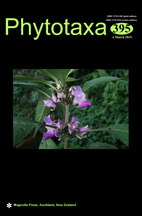Abstract
A taxonomic synopsis of the members of the re-circumscibed Thyrsacanthus from Argentina and Paraguay is presented. Two species are recognized for the region, T. boliviensis and T. sulcatus. The latter is a new combination here proposed, based on Jacobinia sulcata (until now treated in Carlowrightia), that is corroborated by morphological data and geographic distribution as well as molecular phylogenetic information. Thyrsacanthus sulcatus is clearly distinguished from T. boliviensis by its small, white, lilac or pale blue, presumably psychophilous flowers with a narrow tube, instead of the large and red ornithophilous flowers with a tube that widens to the throat, which is typical of other species of Thyrsacanthus. Differences between the re-circumscribed Thyrsacanthus and other genera of the Tetramerium lineage to which it belongs are discussed, and references to additional genera of Acanthaceae that present similar wide diversification in floral morphology are noted. The synopsis includes a key, full synonymies, descriptions, illustrations, distributions, and lists of representative specimens. Lectotypifications are provided for the following names: Anisacanthus malmei, Dianthera sulcata, Jacobinia caducifolia, Schaueria caduciflora, and Siphonoglossa gentianifolia.

